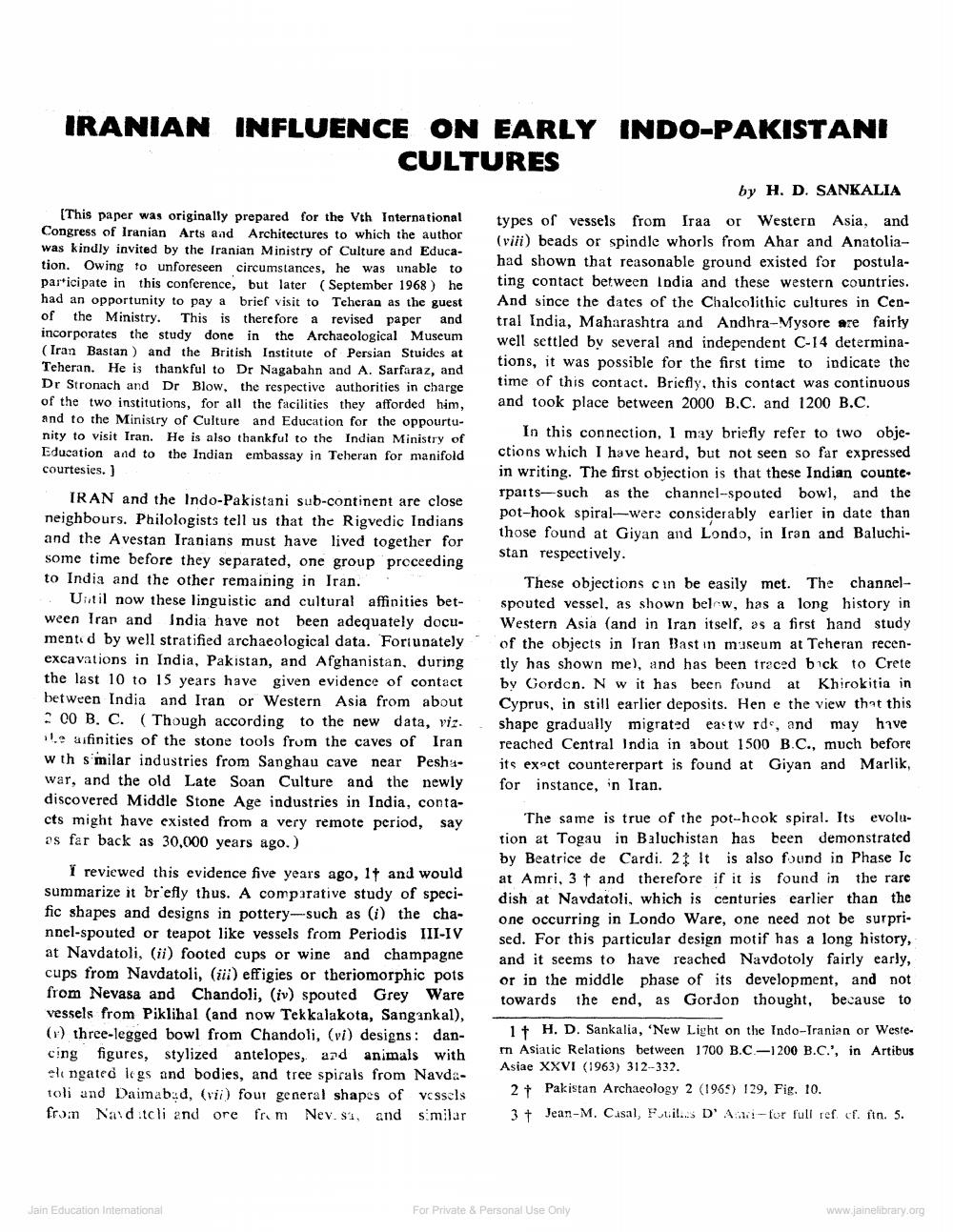________________
IRANIAN INFLUENCE ON EARLY INDO-PAKISTANI CULTURES
by H. D. SANKALIA (This paper was originally prepared for the Vth International types of vessels from Iraa or Western Asia, and Congress of Iranian Arts and Architectures to which the author
(viii) beads or spindle whorls from Ahar and Anatoliawas kindly invited by the Iranian Ministry of Culture and Education. Owing to unforeseen circumstances, he was unable to
had shown that reasonable ground existed for postulaparticipate in this conference, but later (September 1968 ) he
ting contact between India and these western countries. had an opportunity to pay a brief visit to Teheran as the guest And since the dates of the Chalcolithic cultures in Cenof the Ministry. This is therefore a revised paper and tral India, Maharashtra and Andhra-Mysore are fairly incorporates the study done in the Archaeological Museum
well settled by several and independent C-14 determina(Iran Bastan) and the British Institute of Persian Stuides at
tions, it was possible for the first time to indicate the Teheran. He is thankful to Dr Nagabahn and A. Sarfaraz, and Dr Stronach and Dr Blow, the respective authorities in charge
time of this contact. Briefly, this contact was continuous of the two institutions, for all the facilities they afforded him, and took place between 2000 B.C. and 1200 B.C. and to the Ministry of Culture and Education for the oppourtu
In this connection, I may briefly refer to two objenity to visit Iran. He is also thankful to the Indian Ministry of Education and to the Indian embassay in Teheran for manifold
ctions which I have heard, but not seen so far expressed courtesies.)
in writing. The first objection is that these Indian counte. IRAN and the Indo-Pakistani sub-continent are close
rparts-such as the channel-spouted bowl, and the neighbours. Philologists tell us that the Rigvedic Indians
pot-hook spiral-wera considerably earlier in date than and the Avestan Iranians must have lived together for
those found at Giyan and Londo, in Iran and Baluchisome time before they separated, one group proceeding
stan respectively. to India and the other remaining in Iran.
These objections cin be easily met. The channelUntil now these linguistic and cultural affinities bet- spouted vessel, as shown below, has a long history in ween Iran and India have not been adequately docu- Western Asia (and in Iran itself, as a first hand study mentid by well stratified archaeological data. Fortunately of the objects in Tran Bast in museum at Teheran recenexcavations in India, Pakistan, and Afghanistan, during tly has shown me), and has been traced back to Crete the last 10 to 15 years have given evidence of contact by Gorden. Nw it has been found at Khirokitia in between India and Iran or Western Asia from about Cyprus, in still earlier deposits. Hen e the view that this 200 B. C. (Though according to the new data, viz..
shape gradually migrated eastw rds, and may have 1. afinities of the stone tools from the caves of Iran reached Central India in about 1500 B.C., much before wth similar industries from Sanghau cave near Pesha- its exact countererpart is found at Giyan and Marlik, war, and the old Late Soan Culture and the newly for instance, in Iran. discovered Middle Stone Age industries in India, contacts might have existed from a very remote period, say
The same is true of the pot-hook spiral. Its evoluas far back as 30,000 years ago.)
tion at Togau in Baluchistan has been demonstrated
by Beatrice de Cardi. 2 It is also found in Phase Ic I reviewed this evidence five years ago, 17 and would
at Amri, 3 t and therefore if it is found in the rare summarize it br efly thus. A comparative study of speci- dish at Navdatoli, which is centuries earlier than the fic shapes and designs in pottery-such as (i) the cha
one occurring in Londo Ware, one need not be surprinnel-spouted or teapot like vessels from Periodis III-IV
sed. For this particular design motif has a long history, at Navdatoli, (ii) footed cups or wine and champagne
and it seems to have reached Navdotoly fairly early, cups from Navdatoli, (iii) effigies or theriomorphic pots
or in the middle phase of its development, and not from Nevasa and Chandoli, (iv) spouted Grey Ware
towards the end, as Gordon thought, because to vessels from Piklihal (and now Tekkalakota, Sangankal), () three-legged bowl from Chandoli, (vi) designs : dan
1+ H. D. Sankalia, 'New Light on the Indo-Iranian or Westecing figures, stylized antelopes, and animals with
m Asiatic Relations between 1700 B.C.-1200 B.C.', in Artibus slingated legs and bodies, and tree spirals from Navda
Asiae XXVI (1963) 312-332. toli and Daimab:d, (vii) four general shapes of
2 + Pakistan Archaeology 2 (1969) 129, Fig. 10.
vessels fron Nanditcli and ore from Nev.si and similar 3 + Jean-M. Casal, Fuuil. D' A -for full ref of fun. 5.
Jain Education Intemational
For Private & Personal Use Only
www.jainelibrary.org




